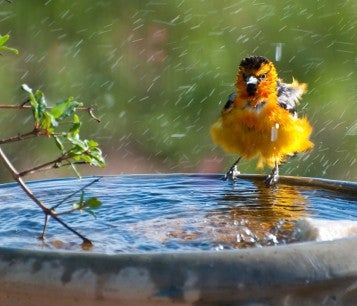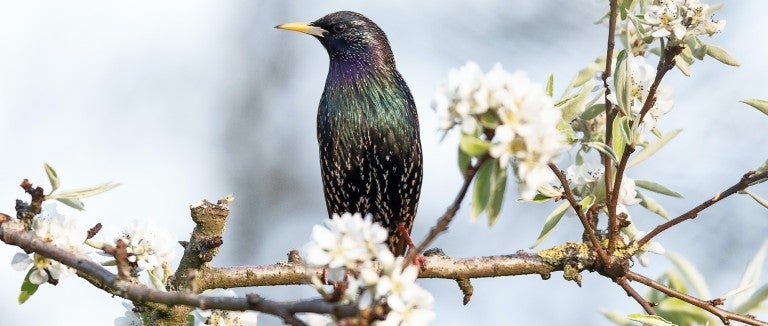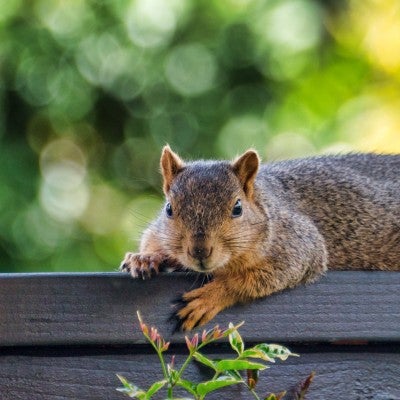European starlings are widespread across North America. They eat a wide variety of foods and are willing to use a wide variety of places to nest and roost. This flexible nature helps them thrive in cities and suburbs as well as on farms. They are one of only a few birds who live in otherwise barren industrial urban wastelands.
Starlings only nest in cavities and are happy to use those provided by people—stove, dryer, and exhaust fan vents, for example—are popular nest sites, along with the bird houses we put up.
But people also complain about starlings getting in the trash. And settling in numbers onto lawns, where they are undoubtedly providing a service by eating insects.
More seriously, large flocks—up to tens of thousands of birds—sometimes roost in urban places where their noise and droppings are extremely unwelcome.
Common problems and solutions
Prevention
It’s best to keep starlings out before they start to build their nest. Ask yourself, “Have they nested in a vent before?” “Is there a cavity on the house they might like?” Seal any openings before they appear and start building. If you discover them building before eggs are laid, remove the nest and appropriately cover the opening they were using.
Sealing openings
Use hardware cloth, metal flashing, or commercial vent covers to seal opening, (the commercially available ones are probably the easiest to work with). Lighter material, such as plastic netting or window screening, rarely keeps determined starlings out. Any vent covering you use for starlings should be checked periodically to make sure the vent is working properly and is not impeded by a build-up of any material, such as lint from a dryer.
Identifying an active nest
You’ll know there are chicks in the nest when you hear the sound of begging nestlings. Active nests are also often marked by a fan-shaped trail of smeared droppings below a corner joint or other entrance to a cavity. Birds using vents make noise that the vent itself tends to amplify. Act right away if you hear scratching and shuffling.
Nests in building cavities and vents
Starlings will use any hole they can get into if it leads to a suitably sized cavity. Dryer, stove, and bathroom vents are ideal. A vent with a metal flap may not deter them: they can hover or perch while raising the flap to get into vents.
Vents with nests inside may not function properly. This can be inconvenient or, in some cases, unsafe. The nesting material may need to be removed immediately.
Sometimes young starlings get caught in vents, falling into open spaces that they can’t escape. This may be especially true of microwave and stove hood exhaust vents. To help a starling out of one of these vents, you may need to remove the hood or microwave, so you might want to call a professional.
If eggs or young are already in the nest, can this vent be left unused until they fledge? If so, treat this nest like a nest in an attic or similar cavity.
Nests in attics and similar cavities
If you find eggs or young birds in attics or similar cavities, leave them be. You may have to wait about 12 days for eggs to hatch and up to 3 weeks for young to leave the nest. Check the nest frequently—once the young leave the nest, remove the nesting material, and seal the openings.
Removing the nest
If young are present in a vent or other space, and there is no option to leave them there until they fledge, the parents can still raise their young in an alternate nest.
- Make a substitute nest from a wicker basket, a plastic gallon jug, or a birdhouse designed for medium-sized woodpeckers.
- Cut an U shape opening in the plastic jug and flip the “door” up to keep rain out.
- Attach the substitute nest as close as possible to the original nest, but in as much shade as possible.
- Carefully remove nesting material and nestlings, and place in substitute nest.
Noisy nestlings usually attract the parents who will continue to care for them. Watch the substitute nest to see that the adults return. They should not take more than a half hour or so, as growing young birds need constant feeding. If the adults do not return to nestlings, contact a wildlife rehabilitator in your area for advice.
Finally and importantly, if it was a vent that you vacated, promptly install a vent cover to keep other starlings, and other birds, out.
Removing the eggs
Substitute nests won’t work with eggs. However, we recommend leaving them to complete the cycle for this one nesting period.
Legal consideration
Though federal law allows you to remove starling and house sparrow eggs, it is illegal to remove the nests or eggs of all other birds.
No matter how big or small your outdoor space, you can create a haven for local wildlife. By providing basic needs like water, food and shelter, you can make a difference in your own backyard.

In yards and public places
Please tolerate starlings in spring, when visiting flocks probe the grass for grubs and clean up insects among the new growth. They are actually performing a service.
In a few towns and cities, starlings form extremely large, noisy, and messy roosts. City starlings tend to prefer large buildings—office buildings and warehouses—and other structures—industrial complexes and bridges—for roosts.
Large numbers of starlings are killed each year because they eat crops and livestock feed, and leave droppings.
Long term solutions
Even scientists who work for the agency that kills many starlings have concluded that all the killing probably has little impact on the overall population. (Though it certain causes suffering to those birds who are killed.)
Other scientists instead suggest that reducing the number of nesting sites may be the key to limiting the population. Malls, small shopping centers, warehouses, barns, and even office buildings offer many nest cavities. A humane way to keep starling populations down is to close off current and potential nest cavities to prevent more birds from hatching rather than kill birds.
This kind of exclusion can be practiced systematically, since starlings may move from one preferred to another less preferred but available site nearby. By watching, monitoring, and reacting to this until there is exclusion on an area-wide basis, local governments can resolve many problems with starlings.
Open overfilled dumpsters and household trash in plastic bags offer easy urban meals. Take them off starlings’ menu by securing trash.
Humane harassment can persuade starlings to move from roost sites where they are particularly unwelcome. To be most effective, combines techniques in a comprehensive program.
Competing with other songbirds
Many other birds nest in cavities, including birds who are more popular than starlings. Some woodpeckers, in particular, prefer the same cavities as starlings.
When there are starlings in the neighborhood, other cavity-nesting birds sometimes come up short. People may recall that bluebirds declined in the early part of the last century after European starlings and house sparrows were introduced. But a recent study of the populations of 27 native cavity-nesting species found starlings impact to be practically nonexistent. Only sapsuckers may have declined because of starling.
You can put up birdhouses with small entrance holes to allow smaller cavity-nesting birds (such as bluebirds) in and starlings out.
Public health and starlings
Dropping accumulation under roosts can encourage histoplasmosis fungus to grow in the soil. When disturbed, spores can become airborne, and people can breathe them in. Most people have no apparent ill effects. A few develop respiratory disease and a very few develop disease of other organs.
Histoplasmosis fungus is common to soils in the eastern and central United States. As many as 80 % of people tested in these areas prove to have already been exposed without knowing. It is important to note that the birds (and bats) associated with this disease don’t carry or spread it; they simply provide the rich nutrients that can allow it to grow and proliferate. Many factors will go into whether or not conditions are right for this as well as how people might become exposed. Certainly soil disturbance plays an important role in risk of exposure.
People diagnosed with histoplasmosis typically work where bird or bat droppings accumulated (poultry farmers, contractors clearing old buildings) or explore caves where bats lived rather than merely live near starling roosts. Despite the very small risk of harm to people, histoplasmosis has been used to justify killing starlings where the nuisance of large roosts annoys people.

